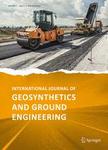版权所有:内蒙古大学图书馆 技术提供:维普资讯• 智图
内蒙古自治区呼和浩特市赛罕区大学西街235号 邮编: 010021

作者机构:Natl Inst Technol Rourkela India James Cook Univ Townsville Qld Australia Calif State Univ Sacramento Sacramento CA 95819 USA
出 版 物:《INTERNATIONAL JOURNAL OF GEOSYNTHETICS AND GROUND ENGINEERING》 (Int. J. Geosynth. Ground Eng.)
年 卷 期:2017年第3卷第4期
页 面:1-14页
主 题:Reduction factor Rectangular foundation Sand Eccentric load ANN ANFIS
摘 要:Extensive laboratory model tests were conducted on a rectangular embedded foundation resting over homogeneous sand bed and subjected to an eccentric load to determine the ultimate bearing capacity. Tests were conducted for foundations with width-to-length ratios (B/L) of zero (strip case), 0.333, 0.5, and 1. The depth of embedment varies from 0 to 1B with an increment of 0.5B;where B is the width of foundation and the eccentricity ratio (e/B) varies from 0 to 0.15 with an increment of 0.05. Based on the laboratory model test results, two different approaches are proposed to determine the ultimate bearing capacity. Firstly, a neural network model is developed to estimate the reduction factor. The reduction factor can be used to estimate the ultimate bearing capacity of an eccentrically loaded foundation from the ultimate bearing capacity of a centrally loaded foundation. A thorough sensitivity analysis was carried out to determine the important parameters affecting the reduction factor. Importance was given to the construction of neural interpretation diagram. Based on this diagram, whether direct or inverse relationships exist between the input and output parameters were determined. Secondly, an adaptive neuro-fuzzy interface system (ANFIS) is used to predict the ultimate bearing capacity. The neuro-fuzzy models combine the transparent, linguistic representation of a fuzzy system with learning ability of artificial neural networks (ANNs). The results from the ANN and ANFIS were compared with the laboratory model test results. It is clearly seen that the performance of the ANFIS model in our study is better than that of the ANN model.